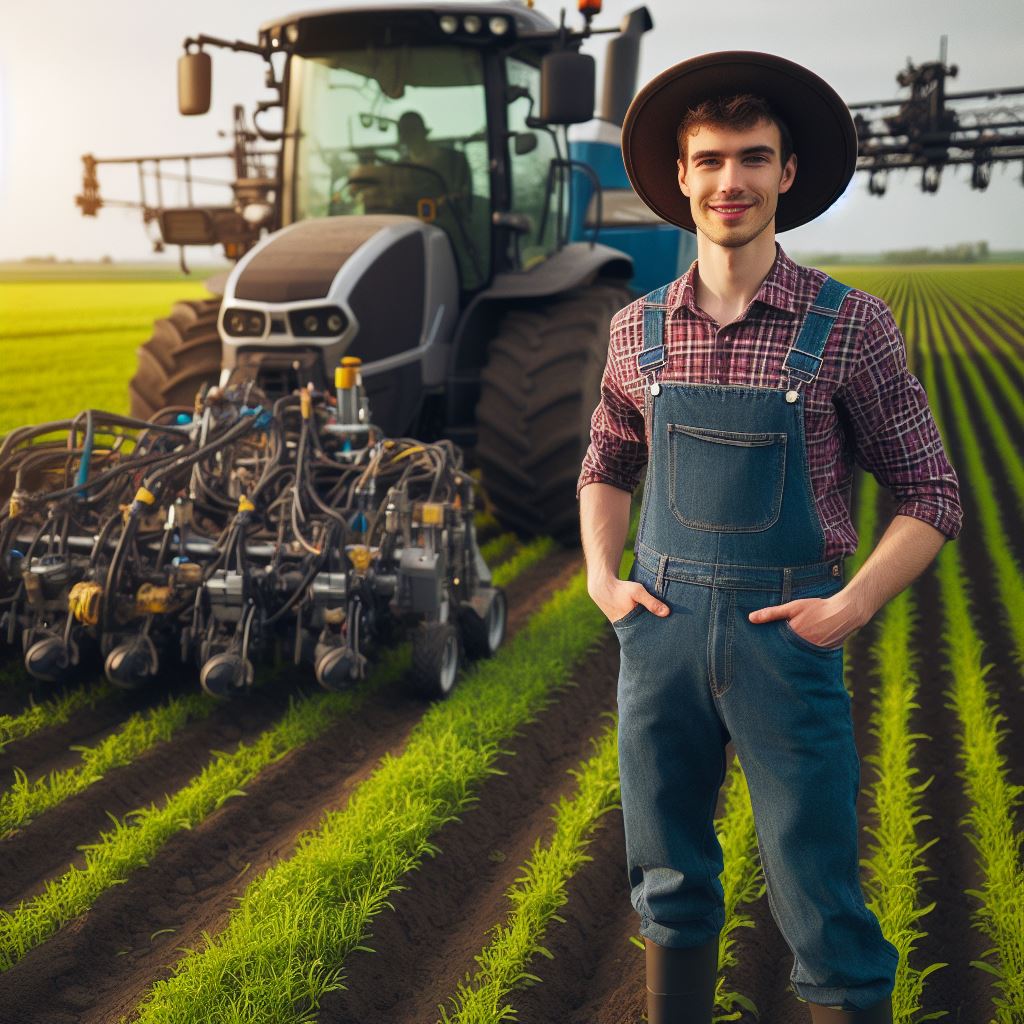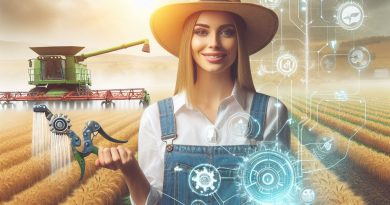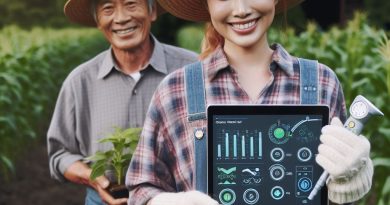Automated Farming: Pros & Cons Explored
Last Updated on January 17, 2024
Introduction
Brief explanation of automated farming
Automated farming refers to the use of technology and machinery in agricultural practices.
It involves the use of robots, drones, sensors, and AI to increase productivity and efficiency in farming operations.
It has gained significant popularity in recent years due to its potential to revolutionize the agricultural industry.
Importance and relevance of discussing pros and cons
Discussing the pros and cons of automated farming is crucial to understanding its implications.
There are several advantages to this technology.
Firstly, it can enhance productivity by automating labor-intensive tasks and reducing dependency on human labor.
Secondly, it enables precise and controlled farming practices, resulting in optimized resource utilization, reduced waste, and improved crop yields.
Additionally, automated farming can contribute to sustainable and environmentally friendly practices by minimizing the use of fertilizers, pesticides, and water.
Potential drawbacks and concerns surrounding automated farming
Despite these benefits, there are also potential drawbacks and concerns surrounding automated farming.
One of the major concerns is the displacement of human workers, as increased reliance on technology may lead to job losses.
Another challenge is the high initial cost of implementing automated systems, which may limit accessibility for small-scale farmers.
Additionally, there are concerns about over-reliance on technology and the potential risks associated with system failures or cyber attacks.
Considering the pros and cons of automated farming is essential for farmers, policymakers, and consumers alike.
It provides valuable insights into the potential impact of this technology on various aspects of agriculture, such as productivity, sustainability, employment, and food security.
By understanding these advantages and challenges, stakeholders can make informed decisions about the adoption and regulation of automated farming practices.
Read: Smart Sensors: Changing Farm Water Use
Pros of Automated Farming
Automated farming offers numerous advantages that revolutionize traditional farming practices.
Let’s explore the pros in detail.
Increased efficiency and productivity
Automated farming embraces the use of advanced technology and machinery, significantly improving efficiency and productivity in agricultural activities.
With automated processes, tasks are completed faster and more precisely, contributing to increased yields and reduced waste.
By introducing automated systems, farmers can streamline various farming operations, such as planting, crop monitoring, and harvesting.
For instance, automated planting machines can precisely distribute seeds at optimal distances, resulting in better crop growth and overall yield.
Additionally, automated harvesting machines can efficiently collect crops, minimizing loss and increasing productivity.
Cost savings
One of the major benefits of automated farming is the reduction in labor costs.
As technology replaces human labor, farmers can significantly reduce their workforce, resulting in substantial cost savings.
Automated machines can perform tasks that previously required manual labor, eliminating the need for additional workers.
Furthermore, automated farming allows for better resource optimization.
Sensors and data analysis can accurately determine the exact amount of water, fertilizers, and pesticides needed for each crop, minimizing waste and maximizing resource utilization.
This optimization leads to cost savings in terms of reducing the amount of resources required for farming operations.
Improved accuracy and precision
Automated farming systems provide precise and accurate execution of farming activities.
Machines can perform tasks consistently without human error, leading to improved outcomes.
Automated seeding machines ensure precise placement of seeds, avoiding overcrowding or gaps in crops, which promotes uniform growth and maximizes yield potential.
Moreover, data-driven decision-making plays a crucial role in automated farming.
Advanced sensors and analytics collect real-time data on crop health, soil conditions, and weather patterns.
This data is then used to make informed decisions regarding irrigation, fertilization, and pest control.
By utilizing accurate data, farmers can optimize farming practices, resulting in improved crop quality and higher yields.
Enhanced safety
Automated farming prioritizes the safety and well-being of farmers by minimizing their exposure to hazardous tasks.
Working on traditional farms often involves physically demanding and potentially dangerous activities.
However, with the introduction of automated systems, farmers can avoid these risks.
By replacing manual labor-intensive tasks with automated machinery, farmers are protected from physical strain and injuries.
Machines can efficiently handle heavy lifting, repetitive tasks, and exposure to harmful substances, reducing the risk of accidents and improving overall safety on the farm.
Basically, automated farming brings a range of benefits to the agricultural industry.
Increased efficiency and productivity, cost savings, improved accuracy and precision, as well as enhanced safety, are among the key advantages.
Embracing automated farming practices can revolutionize the way we cultivate crops and ensure a sustainable and prosperous future for agriculture.
Read: Solar-Powered Irrigation: A Deep Dive
Cons of Automated Farming
In the previous section, we discussed the pros of automated farming, highlighting the various benefits it brings to the agricultural industry.
However, like any other technological advancement, there are also drawbacks that need to be considered.
In this section, we will explore the cons of automated farming.
High setup and maintenance costs
One of the major concerns with automated farming is the high setup and maintenance costs.
Implementing automated systems requires substantial investment in equipment and technology.
Farmers need to purchase advanced machinery, sensors, and software, which can be quite expensive.
Additionally, the maintenance and repair of these systems also require skilled technicians, adding to the overall cost.
Potential job displacement
Another significant drawback of automated farming is the potential job displacement it entails.
As machines take over manual tasks, there is a reduced need for human labor in farming operations.
This trend leads to decreased employment opportunities for manual laborers, who may find it challenging to transition into other industries.
Furthermore, the shift towards automated farming can have adverse effects on rural communities, where agriculture is a primary source of income and employment.
Vulnerability to technological failures
Automated farming systems are also vulnerable to technological failures.
These failures not only disrupt the farming process but also pose risks to the productivity and profitability of farmers.
Dependence on power and connectivity is a major concern as any disruptions or outages can halt automated operations.
Additionally, there is always a risk of malfunctions and system errors, which require immediate attention and can lead to reduced efficiency and increased costs.
Environmental concerns
Environmental concerns are yet another con of automated farming.
Increased energy consumption is a direct consequence of operating automated systems.
The continuous use of machinery, sensors, and other automated equipment requires a significant amount of energy, which can have implications for fossil fuel consumption and carbon emissions.
Additionally, in case of mishaps or accidents, such as system malfunctions or damage to equipment, there is a potential risk of soil and water pollution, which can harm both the environment and human health.
Essentially, while automated farming offers numerous advantages, it is crucial to acknowledge the cons associated with its implementation.
High setup and maintenance costs, potential job displacement, vulnerability to technological failures, and environmental concerns are some of the drawbacks that need to be carefully managed.
Farmers and policymakers must find ways to mitigate these cons and ensure a sustainable and inclusive transition to automated farming for the overall benefit of the agricultural industry and society as a whole.
Read: Agri Robots: The Future of Farming Now

Balancing Automated Farming with Traditional Methods
Integrating automation without fully replacing manual labor
In order to balance automated farming with traditional methods, it is important to find ways to integrate automation without fully replacing manual labor.
One approach is to use automation for repetitive and physically demanding tasks, allowing farmers to focus on more complex and strategic activities.
Collaborative approach for hybrid farming systems
This collaborative approach allows for a hybrid farming system, where both automation and traditional farming methods work together.
By combining the strengths of automation and manual labor, farmers can benefit from increased efficiency and productivity.
However, it is crucial to ensure that the implementation of automation does not have a negative impact on the environment.
Sustainable practices to mitigate negative impact
Farmers should adopt sustainable practices such as precision farming and resource management to mitigate any potential negative effects.
This includes using advanced technologies to monitor soil moisture levels, optimize irrigation, and reduce the use of chemical fertilizers and pesticides.
By implementing sustainable practices, automated farming can help reduce the environmental footprint of agriculture.
Ensuring social and economic well-being of farming communities
In addition to environmental considerations, it is important to prioritize the social and economic well-being of farming communities.
Automation should not lead to job losses or the displacement of farmers; instead, it should create opportunities for skill development and new roles.
Training programs can be implemented to help farmers acquire the necessary skills to operate and maintain automated farming equipment.
Furthermore, governments and organizations should provide support and incentives to encourage the adoption of automated farming technologies.
This can include financial assistance, access to loans, and information sharing to ensure that small-scale farmers are not left behind.
In essence, a balanced approach to automated farming and traditional methods is crucial for the sustainable future of agriculture.
By integrating automation without completely replacing manual labor, farmers can benefit from increased efficiency and productivity.
Collaborative farming systems that combine the strengths of both automation and traditional methods can further enhance the overall success of agriculture.
Through sustainable practices and support for farming communities, the negative impacts of automation can be minimized.
With careful planning and consideration, automated farming can help address the challenges faced by the agriculture industry, while ensuring the well-being of farmers and the environment.
Read: Next-Gen Drip Irrigation: What’s New?
Conclusion
Recap of pros and cons discussed
Automated farming offers several advantages, such as increased efficiency, higher productivity, and reduced labor costs.
However, it also has drawbacks, including initial investment costs and potential job displacement.
Call for further research and development in automated farming
Considering the potential benefits and challenges of automated farming, it is crucial for researchers and developers to continue exploring innovative technologies and practices.
Final thoughts on the future of agriculture and automation
The future of agriculture is undoubtedly tied to automation.
As the global population continues to grow, the demand for food will increase, and automated farming can help address this need.
However, it is vital to strike a balance between automation and preserving traditional farming practices and human labor.
In a nutshell, automated farming holds great promise for the future of agriculture.
It can revolutionize the industry by improving efficiency, sustainability, and food production.
Nevertheless, careful planning and consideration are required to ensure a smooth transition and maximize the benefits of automation in farming.


